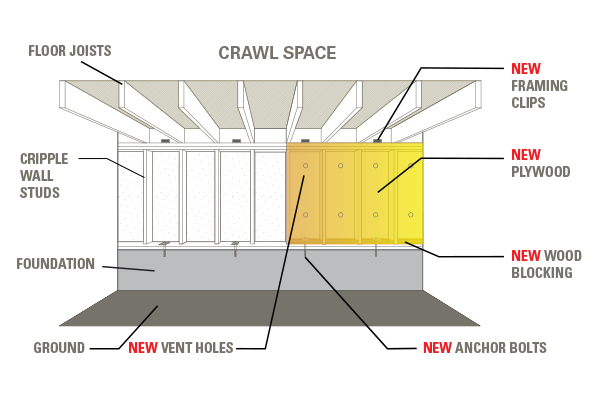Prepare Your Home Against Earthquake Damage
The shaking from a major earthquake can move almost everything inside your home.
According to a UCLA study, the majority of the injuries from the damaging 1994 Northridge Earthquake were from heavy furniture and household objects falling on people. Think about what heavy items could be thrown around or tipped over in your own home.
To be truly prepared for the next earthquake, evaluate the safety of your home. Your home’s earthquake safety review ranks high on your disaster preparation checklist. Next prepare your earthquake safety kit and gather essential supplies. Securing your space can help keep your family safer and prevent the injury of your loved ones.
Watch this educational video for the best way to make your home safe.
Securing Your Space: Prepping Your Home for Earthquake Safety
Water Heaters
Water heaters should be braced consistent with California law. Purchase an authorized strap kit from your hardware store.
Your Kitchen
Ensure that gas appliances have flexible connections. Strap ovens and refrigerators to the walls. Use latches to keep cabinet doors from flying open during an earthquake.
Furniture
Anchor heavy mirrors and pictures over chairs, and couches with wire through eye screws into studs. Locate beds away from windows. Do not hang heavy objects over beds.
Bookcases and Hanging Objects
Strap heavy items like bookcases and shelves to walls to prevent falling. Secure ceiling fans, pendant lighting and other hanging lighting fixtures. Securely fasten or relocate heavy pictures and mirrors over furniture. Do not hang heavy objects over beds, or other places you spend time such as couches in your living room, desks in your home office, or the table in your dining room.
Electronics and Televisions
Strap down televisions, computers and other expensive or hazardous electrical components.
Shelving and Cabinets
Strap bookcases and shelves to walls to prevent tipping. Secure cabinets to wall studs; use latches to keep cabinet doors from flying open during an earthquake.
Small Valuables
Secure your items. Move small breakable valuables to lower open shelves with lip guards, Velcro adhesives or to locked cabinets. You can also use QuakeHOLD! Museum putty to keep delicate items in place.
Tree Limbs
Prune tree limbs adjacent to your home and garage.
Prepare Your Rental Home for an Earthquake
Move heavy objects or large items to the floor or low shelves. Move things that can fall on you away from where you spend a lot of time. Keep heavy or unstable items away from doors and escape routes.
Work with your landlord to have appliances that came with your rental secured. Before installing straps or bracing to walls, ask the landlord if there is a method they prefer or if they want a maintenance person to perform the work.
Make sure that you both understand how these necessary safety elements may affect your security deposit.
Ask Your Landlord
Ask your landlord how your rental home has been strengthened to guard against earthquakes. Check on faults near your home with CEA’s county by county earthquake risk map. Ask the following questions:
- When was the building built?
- Has it been retrofitted? Important to know if it was built before 1980 under older building codes, which would mean it is less resistant to earthquake damage.
- What kind of soil is underneath the building?
- Is the building insured for an earthquake?
California tenant law requires the following must be in working order for a unit to be habitable:
- Electrical
- Hot and cold running water
- Plumbing and a functioning toilet
- Heating and air conditioning
- Windows
- Doors
- Undamaged flooring, ceilings and walls
- No infestations
- If provided as part of your rental agreement, appliances like stove and refrigerator
Avoid Earthquake Damage to Your House
Make your home more resistant to earthquake damage by assessing its structure and contents. Secure your space by checking if your home is anchored to its foundation, has weak crawl space walls, is unbraced post-and-pier foundations or has masonry walls or unreinforced foundation.
Even though most injuries come from flying objects and falls during shaking, you could be financially hit if your house suffers extensive damage or slides off its foundation in an earthquake. If yours was built before 1980, take a good look with a professional engineer and take the steps to secure your older house. Seismic building standards have changed.
Avoid financial disaster if your house sufferers extensive damage with CEA affordable earthquake insurance policies for homeowners.
Is Your Home Anchored to its Foundation?
Two types of houses built before 1980—"stem-wall” and “cripple-wall”—may benefit from retrofitting with foundation anchoring, which reduces the possibility of a house sliding off of its foundation in an earthquake.
“Foundation anchorage” describes both foundation bolts and foundation plates. Either can be used to secure your house frame to its foundation.
For detailed information about foundation anchors, including which method to use, visit Earthquake Brace + Bolt.
Bracing Cripple Walls
Cripple-wall houses have short (less than full-story height) wood-framed walls between the foundation and the wood-framed first floor, and a crawl space under the house.
In addition to requiring foundation anchor-bolts, cripple-wall houses built before 1980 may need plywood bracing to further protect against earthquake damage. Cripple walls are braced by nailing plywood sheathing to the inside of the walls that surround the crawlspace.
Locate Gas Shutoff
Know how to turn off the gas or learn if you should have an automatic gas shut-off valve installed that is triggered by strong vibrations. Consult your local gas company before any work is done.
Repair Deep Ceiling and Foundation Cracks
Repair any deep cracks in ceilings or foundations. Get expert advice if there are signs of structural defects.
How to Store Flammable Liquids
Store weed killers, pesticides, and flammable products securely away from your house in closed cabinets with latches on the bottom shelves.
Get the Facts Before Earthquakes Occur
Prepare your home BEFORE an earthquake. Decrease your risk of damage and injury from a major earthquake by identifying possible structural risks and geologic hazards near you.
Consider earthquake insurance to protect the financial investment you have in your home. CEA policies provide you with the strength to rebuild and repair, funds to live elsewhere while repairs are being made to your home, and help replace your personal property if it is damaged in an earthquake. Contact your insurance agent or residential insurance company to find the CEA policy that is right for you.
Where is the Safest Place to go During an Earthquake?
Shelter in place. Cover your head. Crawl under sturdy furniture such as a heavy desk or table, or against an inside wall. Stay away from where glass could shatter around windows, mirrors, pictures, or where heavy bookcases or other heavy furniture could fall over.
Remember DROP, COVER, and HOLD ON! Drop to the ground, cover your head and neck, and hold on until the shaking stops. Wait until the shaking stops and then check if others are hurt. There may be several AFTERSHOCKS. If you leave the building after the shaking stops, use the stairs. Never use the elevator.
If you are outside, move away from buildings, lights, power lines (electric lines) and trees. Drop and cover your head!
Find out what you should pack in your earthquake supply kit, which has more items than a simple first aid kit.
Understanding Structural Risks
An earthquake’s powerful shaking can rupture the earth, trigger landslides, and turn the surface of the earth to liquid. Your home also may be vulnerable to serious structural damage if it was built before 1980.
Earthquake safety preparation requires your understanding of the potential structural threats to your home in case of an earthquake.
A seismic retrofit involves strengthening your home’s foundation to make it more resistant to shaking. CEA offers earthquake home insurance premium discounts for houses and mobilehomes that have been properly retrofitted. Find out about grants to help pay for retrofits under the Earthquake Brace + Bolt program, and the CEA Brace + Bolt program.
Evaluating Geologic Hazards
With nearly 16,000 known state faults and more than 500 active faults, California is earthquake country. Most of us live within 30 miles of an active seismic risk. Scientists continue to find new faults.
Find out about faults in your area by visiting the CEA risk map for each county. This information will help you create an earthquake precaution checklist.
Then learn about your home’s structural risks and the steps you can take to seismically strengthen your house. California Office of Emergency Services MyHazards can help you find out if the area where you live or work is prone to earthquake-induced landslides.
Do I Need Earthquake Insurance?
Consider following in the event of a large earthquake:
- Earthquakes can cause extensive damage to the foundation, siding and roof of homes. Older homes built before 1980 on a raised foundation are especially vulnerable if they are not retrofitted.
- Without residential earthquake insurance you will be responsible for all repair and/or rebuilding costs.
- Government disaster assistance, if available, only comes in the form of a small grant or capped loan, which may cover only a portion of your repair costs.
- Without Loss of Use earthquake coverage—which includes covering additional expenses of living elsewhere if you have to move because of earthquake damage—you’d still be paying your mortgage plus temporary housing rent during the time repairs are underway.
Our affordable earthquake insurance policies let you select the coverage that fits your budget. CEA insurance rates, based on the latest science and research, are determined by several factors including your home’s age, location near a fault, foundation type, construction type, and roof type.
It is easy to buy earthquake insurance
For the best choice of CEA earthquake insurance policies, select deductibles from 5%-25%.
CEA earthquake insurance is easy to buy. Contact your home insurance agent to discuss adding a separate earthquake policy to your home or renter’s insurance. You can add the coverage today, no need to wait until your home policy comes up for renewal.
CEA works with residential insurance companies that serve the majority of California homeowners.




